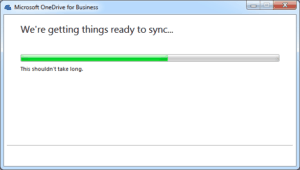SharePoint quietly shifts to OneDrive for a week
Mike Falconer
EPM Consultant
For those of you who have the dubious honour of managing a SharePoint Online drive, you will have needed to find a solution for synchronising your online SharePoint drive to user’s laptops. You will undoubtedly have encountered the dreadful OneDrive for Business. I’ll start with a short rant as to why I think OneDrive for Business is a terrible idea.
To begin, this awful software is not OneDrive, OneDrive for Business is built on technology called Groove. The anecdotal root of the problem is:
- OneDrive works well
- Groove doesn’t work well
Not content with simply not working, Groove also sullies the good name of OneDrive to your users, since the bright sparks at Microsoft decided to market OneDrive and Groove together. How wrong they were. OneDrive by itself is an exceptionally powerful tool which is perfect for personal or business use.
For those unacquainted with OneDrive, it essentially functions as Microsoft’s answer to Dropbox, or similar cloud storage solutions. You install the cheerful blue cloud, and it creates a new documents folder on your PC. Anything stored in this folder will also be synchronised with a secure cloud folder, while also maintaining a local copy.
Having your documents stored locally and online solves the main problem with cloud storage, namely that you still have 100% access to your files when offline (on the train for example). However, keeping it synchronised to the cloud protects you from losing your files if you get the dreaded blue screen of death, or lose your laptop. You can be assured your files are safely stored in the cloud.
Another main benefit of OneDrive is collaboration with colleagues, you can quickly and easily share a folder or file with a friend, allowing you to share your holiday pics over the web, or share responsibility for a report that needs finishing.
SharePoint Online provides an excellent Shared Drive service, which appears as a friendly web interface. The main selling points are security managed at an individual folder level, complete customisation of your SharePoint, and almost unlimited versioning of your files. The last point is an absolute lifesaver for admins. Someone downloaded your template and accidentally saved over the online copy? Simply restore the last version, problem solved!
However, some people don’t like interacting with SharePoint in the web browser, and want a local copy of certain folders in the drive. This is understandable as I explained above, having a local copy can be useful when you’re working offline, and it also means you can interface with the Shared Drive using Windows Explorer rather than the web app.
This is the point of my blog – one of the weak points of SharePoint is using Groove to connect it to user’s laptops. It’s unreliable, slow, and throws up so plenty of problems. Unfortunately, you’re stuck with it now until Microsoft revert the button behaviour back to using OneDrive. So, how do I set up a user with local access to the SharePoint drive? The answer is the Sync button:

For about a week or two, the Sync button had slightly different behaviour, and booted up your OneDrive client rather than Groove. We managed to get most of our users set up powering local synchronisation through OneDrive rather than Groove, but the default now seems to be back to using Groove again. Regardless, hitting Sync will bring up the below screen, press Sync now to continue setting it up:

Your OneDrive for Business client should open up, and now you can change where you want your Shared Drive to save:

Pressing Sync now will bring up this never-ending loading screen:

“This shouldn’t take long” – this should be Groove’s epitaph
After what seems like an age:

Your files will start syncing into the shared drive folder that you’ve createed.

Now all you have to do is wait until it breaks, and it will break, until Microsoft get their act together and switch to OneDrive permanently.
Until then, I will lord my SharePoint connected OneDrive over you all!

Got any tips on how to subvert the sync button and set up synchronisation similar to the screenshot above? Drop us a message!
Until next time,
Mike








 +44 (0)1483 685450
+44 (0)1483 685450 contact us
contact us